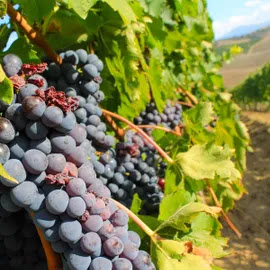While doing a bit of spring cleaning in my cellar, I unearthed a bottle of 2014 Vignobles Levet Côte Rôtie Les Journaries. Medium garnet in color, the wine was floral and full of black fruits on the nose. Acidity was very high, and body was medium plus. On the palate, it was elegant with well-integrated tannins, a savory note, and an incredibly long finish. While savoring this gem, I decided to dig into what makes Côte Rôtie so special.
 |
| 2014 Vignobles Levet Côte Rôtie Les Journaries |
Roasted Slope and Racy Grapes
Located on the northernmost end of the Rhône Valley wine region in France, Côte Rôtie is often translated to the Roasted Slope. This is attributed to the steep slopes or hillsides that rise up to 1,150 feet (over 330 meters) off the banks of the Rhône River, allowing for maximum sun exposure on the vineyards.
In some areas, the sharp incline gets up to 60 degrees. That with the constant risk of erosion bring unique challenges to vine growing. Vineyards are planted in terraces. Since there is no way to use tractors and other machinery on the slopes, tending to the vines and grape harvesting have to be done by hand.
The grapes grown in the region are mostly Syrah and a small amount of Viognier. With 224 hectares (or 550 acres) of vineyards, Côte Rôtie is one of the smallest appellations in the Rhône Valley. It is about a third the size of Walla Walla Valley and only about 1.2% the size of Napa Valley.
To qualify as Côte Rôtie AOC (Appellation d'Origine Contrôlée), the wine needs to be made with predominantly Syrah and up to 20% of Viognier. The rules also require that the grapes be co-fermented rather than fermented separately and blending afterwards. It is believed that the co-fermentation with Viognier, a white grape, stabilizes the color of Syrah and also adds a floral note to the savory wine.
The Brunette or the Blonde
There are two main hills in Côte Rôtie where some of the best wines are made. According to folklore, a feudal landlord gifted his two daughters each a hill. The hill that went to the dark-haired daughter is known as Côte Brune while the hill that went to the light-haired daughter is called Côte Blonde.
The soil of Côte Brune is mostly reddish-brown mica schist and is rich in iron. Côte Brune is often made with 100% Syrah. The wine tends to be tannic, structured, and powerful with good aging potential. Côte Blonde has pale yellow gneiss soil that is similar to granite. It is more likely to be co-fermented with Viognier. The wine is lighter, fruitier, and more approachable when enjoyed young.
But why pick a Blonde or a Brune when you can have the best of both worlds? Renowned Rhône winery and négociant, Guigal, has you covered with its Brune et Blonde that retails for around US$70 a bottle. Feeling spendy? For about twice the price, you can get Guigal’s higher-end Château d'Ampuis, that is made with grapes from seven select terroirs on both hills. Château d'Ampuis is known to be incredibly perfume-y and combines muscle (from Brune) and elegance (from Blonde) beautifully.
The La Las
Next, let’s zoom into three famous vineyards in Côte Rôtie known as the La Las. They stand for La Mouline, La Landonne, and La Turque, the vineyards behind Guigal’s single-vineyard wines. The La Las rose to fame when they started receiving multiple 100 points from Robert Parker in the 1980’s. Today, Guigal’s La La wines run north of US$300 a bottle.
La Mouline, located in Côte Blonde, is the oldest vineyard with a history that goes back 2,400 years. It is also the first of Guigal’s single-vineyard wines with the inaugural vintage of 1966. La Mouline is a monopole, which means that Guigal is the sole wine producer for that vineyard. About 10% of Viognier is typically used in La Mouline, making the wine floral and elegant with complex aromatics.
 |
| Guigal vineyard in Côte Blonde |
La Landonne is the second single-vineyard wine released by Guigal. Located in Côte Brune, it is made with 100% Syrah and is the most powerful and structured of the La Las. It also has the longest aging potential. La Landonne was planted by the namesake winery founder Etienne Guigal in 1975 to honor the birth of his grandson, Philippe. Unlike La Mouline, La Landonne is not a monopole. You will see La Landonne wine by other producers, such as Rene Rostaing and Bernard Levet. In fact Levet’s Les Journaries is made predominantly from La Landonne grapes.
La Turque, Guigal’s third single-vineyard wine, is located north of Côte Blonde and into Côte Brune. It was re-planted in 1980 and 1981 with mostly Syrah and a small amount of Viognier. In terms of style, it marries the power of La Landonne with the elegance of La Mouline. Like La Mouline, La Turque is also a monopole.
 |
Guigal’s La La wines
|
In November 2021, Guigal announced the addition of a fourth La to the collection - La Reynarde in Côte Brune. Just as La Landonne was a tribute to Philippe Guigal, La Reynarde will be dedicated to his twin sons, Charles and Etienne. The vineyard went into construction in 2010, the birth year of the boys. Syrah vines were planted in 2015, and the first vintage is expected to be from 2022.
My Verdict: For a very small appellation, there is certainly a lot to discover in Côte Rôtie. The Les Journaries has given me a flavor of the power of a Côte Brune. It will be fun to do a horizontal tasting of Côte Brune and a Côte Blonde, or better still, a horizontal tasting of the La La wines! Do you have a favorite Côte Rôtie? I’d love to hear what you think.




































